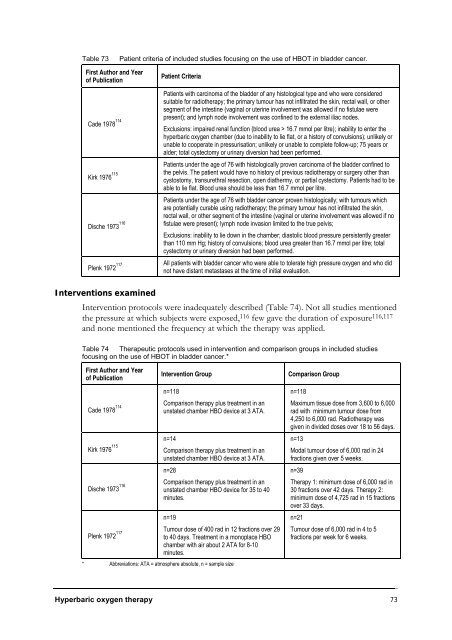Hyperbaric Oxygen Therapy - Hyperbaric Chamber Information ...
Hyperbaric Oxygen Therapy - Hyperbaric Chamber Information ...
Hyperbaric Oxygen Therapy - Hyperbaric Chamber Information ...
You also want an ePaper? Increase the reach of your titles
YUMPU automatically turns print PDFs into web optimized ePapers that Google loves.
Table 73 Patient criteria of included studies focusing on the use of HBOT in bladder cancer.<br />
First Author and Year<br />
of Publication<br />
Cade 1978 114<br />
Kirk 1976 115<br />
Dische 1973 116<br />
Plenk 1972 117<br />
Patient Criteria<br />
Patients with carcinoma of the bladder of any histological type and who were considered<br />
suitable for radiotherapy; the primary tumour has not infiltrated the skin, rectal wall, or other<br />
segment of the intestine (vaginal or uterine involvement was allowed if no fistulae were<br />
present); and lymph node involvement was confined to the external iliac nodes.<br />
Exclusions: impaired renal function (blood urea > 16.7 mmol per litre); inability to enter the<br />
hyperbaric oxygen chamber (due to inability to lie flat, or a history of convulsions); unlikely or<br />
unable to cooperate in pressurisation; unlikely or unable to complete follow-up; 75 years or<br />
alder; total cystectomy or urinary diversion had been performed.<br />
Patients under the age of 76 with histologically proven carcinoma of the bladder confined to<br />
the pelvis. The patient would have no history of previous radiotherapy or surgery other than<br />
cystostomy, transurethral resection, open diathermy, or partial cystectomy. Patients had to be<br />
able to lie flat. Blood urea should be less than 16.7 mmol per litre.<br />
Patients under the age of 76 with bladder cancer proven histologically; with tumours which<br />
are potentially curable using radiotherapy; the primary tumour has not infiltrated the skin,<br />
rectal wall, or other segment of the intestine (vaginal or uterine involvement was allowed if no<br />
fistulae were present); lymph node invasion limited to the true pelvis;<br />
Exclusions: inability to lie down in the chamber; diastolic blood pressure persistently greater<br />
than 110 mm Hg; history of convulsions; blood urea greater than 16.7 mmol per litre; total<br />
cystectomy or urinary diversion had been performed.<br />
All patients with bladder cancer who were able to tolerate high pressure oxygen and who did<br />
not have distant metastases at the time of initial evaluation.<br />
Interventions examined<br />
Intervention protocols were inadequately described (Table 74). Not all studies mentioned<br />
the pressure at which subjects were exposed, 116 few gave the duration of exposure116,117 and none mentioned the frequency at which the therapy was applied.<br />
Table 74 Therapeutic protocols used in intervention and comparison groups in included studies<br />
focusing on the use of HBOT in bladder cancer.*<br />
First Author and Year<br />
of Publication<br />
Cade 1978 114<br />
Kirk 1976 115<br />
Dische 1973 116<br />
Plenk 1972 117<br />
Intervention Group Comparison Group<br />
n=118<br />
Comparison therapy plus treatment in an<br />
unstated chamber HBO device at 3 ATA.<br />
n=14<br />
Comparison therapy plus treatment in an<br />
unstated chamber HBO device at 3 ATA.<br />
n=28<br />
Comparison therapy plus treatment in an<br />
unstated chamber HBO device for 35 to 40<br />
minutes.<br />
n=19<br />
Tumour dose of 400 rad in 12 fractions over 29<br />
to 40 days. Treatment in a monoplace HBO<br />
chamber with air about 2 ATA for 8-10<br />
minutes.<br />
* Abbreviations: ATA = atmosphere absolute, n = sample size<br />
n=118<br />
Maximum tissue dose from 3,600 to 6,000<br />
rad with minimum tumour dose from<br />
4,250 to 6,000 rad. Radiotherapy was<br />
given in divided doses over 18 to 56 days.<br />
n=13<br />
Modal tumour dose of 6,000 rad in 24<br />
fractions given over 5 weeks.<br />
n=39<br />
<strong>Therapy</strong> 1: minimum dose of 6,000 rad in<br />
30 fractions over 42 days. <strong>Therapy</strong> 2:<br />
minimum dose of 4,725 rad in 15 fractions<br />
over 33 days.<br />
n=21<br />
Tumour dose of 6,000 rad in 4 to 5<br />
fractions per week for 6 weeks.<br />
<strong>Hyperbaric</strong> oxygen therapy 73



